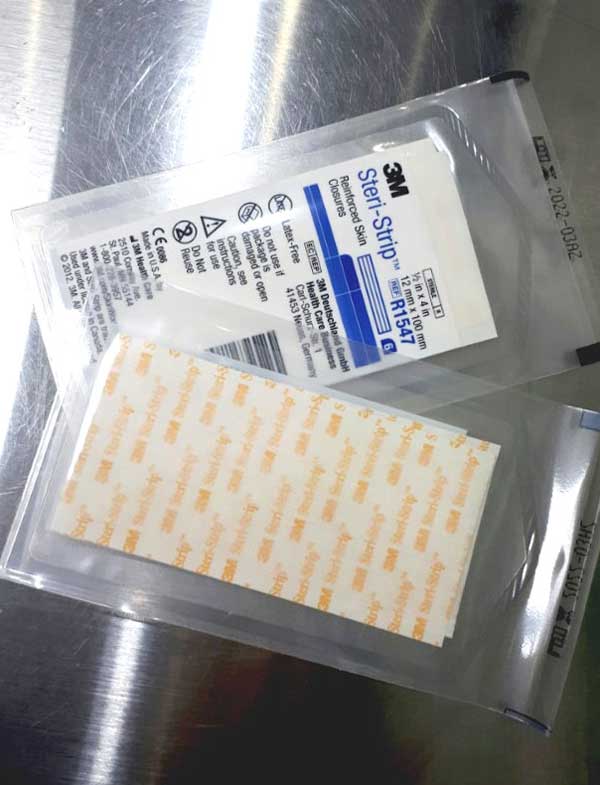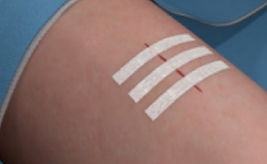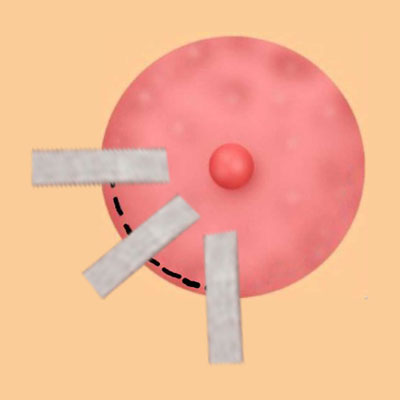In Evita Clinic, we use a tape named Steri-Strip for wounds after surgery. Gynecomastia, liposuction, tummy tuck, breast augmentation, and so on, these Steri-Strips are very widely used. The big advantage of this Steri-Strip is that it reduces scars. But apparently it looks like a regular bandage or tape, and it does not have any special ingredients that reduce the scar. If so, by what principle does it reduce scarring?

Let’s look at the characteristics of the Steri-Strip. This is different from regular bandages and tapes. First, since it is sterilized, it can be attached directly to the wound area. And because it has strong adhesion, it prevents the wounds from spreading. It prevents sutures from spreading or big scarring. Also, it does not stimulate the skin much. It does not cause irritation or allergic reactions to the skin even after repeated use over a long period of time. If you apply sterilization, like betadine or povidone, or hydrogen peroxide on the Steri-Strip directly, it will be absorbed well. So you don’t need to remove the band before dressing. This is because the Steri-Strip is semi-permeable and thanks to this it is much easier to manage.
Let’s look more closely at how this prevents scarring. Usually, when a wound occurs, it is sutured. And if the wound heals enough, stitches can be removed. However, these stitches may leave marks. If you do not want to leave as much stitch marks as possible, it is best to remove stitches as soon as possible. On the other hand, removing stitches too late will reduce the chance of spreading the wound, but it will leave lots of marks, and in some cases, the stitch marks may be more noticeable than the scar itself.
Therefore, after a wound is sutured, the stitches should be removed. And this may vary slightly depending on the surgical site and the method of suture. There is a slight difference in each individual patients, the wound is different in the state. So we have to remove the stitches at a suggestive time. Occasionally, the stitch marks will not be visible, but the sutured area may re-open and causing wound again. Or the suture line may open slightly.
There are various reasons and types of scars that occur during the recovery of these wounds. The biggest reason is the movement of the body. When there is some tension to a wound that has not healed enough, the scar becomes increasingly larger with the wound open. When the Steri-Strip is attached, it will prevent the suture area from spreading also prevent expanding the scarring.

In addition, hypertrophic scars may occur due to excessive production of keratin components, depending on the surgical site or immune difference of an individual. In this case, the effect of pressing the wound with sustained pressure helps. In this case, the Steri-Strip gives a compressing effect. It has the effect of preventing hypertrophic scars or keloid scars.
In some cases, Steri-Strips are used instead of suture surgery. However, this is not possible in all cases. There is no need to suture because the wound is not so deep, but it is used when there is a possibility of scarring if left untreated. In addition, infants may have difficulty in suturing because they are difficult to anesthetize. In this case, it can be effectively used as an alternative to suture surgery.

Now let’s look at how to use Steri-Strips. We, Evita Clinic, individually guide you to the situation of each patient. For basic use, first disinfect the wound site properly with hydrogen peroxide and clean water. If the blood stains from the wound, it may be difficult to securely attach the Steri-Strip, so it is necessary to hold the sterilization gauze for 5 to 10 minutes to stop the bleeding.
When the blood stops, now you may attach the Steri-Strip at the right angle to the wound’s direction. You can also apply a disinfectant such as Betadine on top of the applied Steri-Strip. If you have blood or exudation, you can cover it with a disinfectant gauze or bandage on top of it.

When you are dressing the next day, remove the gauze and leave the Steri-Strip. You can apply betadine or povidone disinfectant on the Steri-Strip. As mentioned earlier, one of the advantages of Steri-Strip is that it is semi-permeable. Therefore, Steri-Strips can be disinfected without removing them. It is best to disinfect it with betadine when you sterilize it on Steri-Strip.
The period for replacing the Steri-Strip is not fixed. If the Steri-Strips attached after removing the stitches, the adhesive strength decreases as time goes by. Usually it is suggestive to change every 3-5 days. Usually more than 3 days are well maintained. If the adhesive strength weakens and when it seems like peeling off, then replace it. If you apply directly to the injured wound instead of suturing, it is not necessary to remove the Steri-Strips until the wound is healed. Disinfection is easy to be on the Steri-Strip directly, because the permeability is good. If there is a lot of discharging and needs to be changed, keep it with your fingers so that the wound does not open and carefully replace it with a new one.

It is recommended to use more than 4 weeks for the purpose of preventing scar spreading after removal of stitches. After 4 weeks, most of the suture sites are healed. Of course, depending on the status of each individual, the recovery time is different, so sometimes it is suggestive to use Steri-Strips over a month sometimes over 6 months.
In recent years, medical techniques and supplies are so developed, and if you follow the instructions well, you should not worry about scars. Depending on the status of the individual, the usage may vary slightly.
Please feel free to contact us via our website or E-mail.
